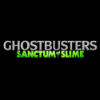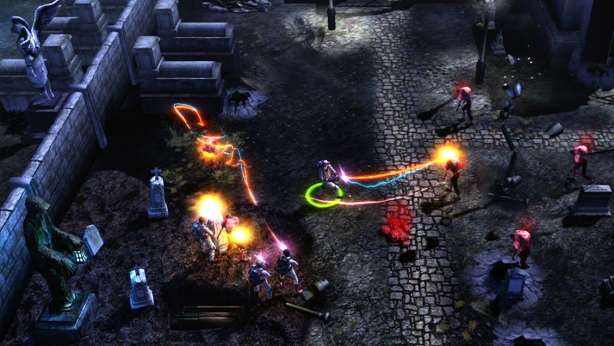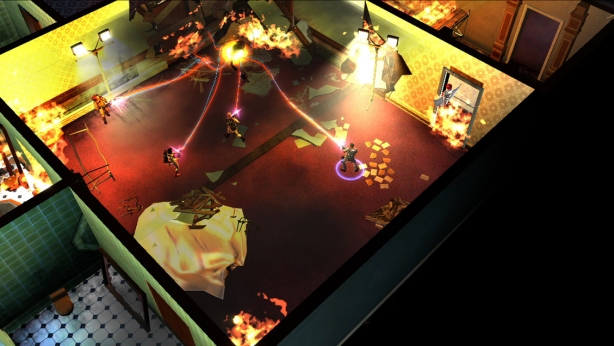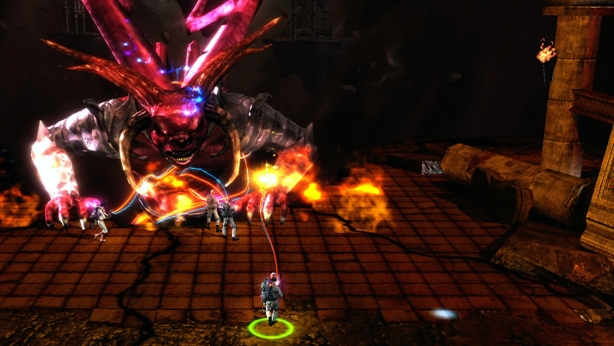Ghostbusters: Sanctum Of Slime Review
 Game: Ghostbusters: Sanctum Of Slime
Game: Ghostbusters: Sanctum Of Slime
Developer: Wanako Studios
Publisher: Atari
Available On: Xbox LIVE Arcade, PC, PlayStation Network (Xbox 360 Version Reviewed)
When Ghostbusters: The Video Game was released in 2009, gamers were promised that the third film in the Ghostbusters trilogy had now been made, and was playable. After a long and protracted development time, and despite a huge budget being spent, the game received a mixed reception upon release. Although it was praised for its story-telling and faithfulness to the source material, some didn’t find the gameplay satisfying enough and the title never performed very well at retail.
Despite the Ghostbusters franchise being so rich with fiction, and thus ripe for new games, Atari couldn’t gamble on another full release after the financial failure of the first game. So they decided to try something different: an arcade-style twin-stick shooter that would be download only. That way the universe could continue to be explored, but on a tighter budget. Does the move pay off? Turn on your PKE meters and we’ll see what we can detect.
STORY: The game kicks off with a comic book style cinematic that follows an ancient cult who worshipped the long-dead tyrant spirit Dumazu The Destroyer. Thousands of years ago he was entombed, but now he waits for the day he can return and bring forth Hell on earth. Fast forward to modern day New York, and the last remaining member of the cult is hidden away in a Mental Asylum. Strangely, his room-mate is Janosz Poha, who you might remember from the so-so Ghostbusters 2 film. The two escape the asylum and, after tracking down the relic that has been housing the life-force of Dumazu, set about unleashing the angry spirit upon the unsuspecting city.
Cut to Ghostbuster HQ, and the team have been busier than ever as they deal with the increased supernatural activity linked to the return of The Destroyer. Unable to handle the workload on their own, the team turn to a group of rookie recruits which they can send on the missions they are too tired to go on. Meet Alan, Sammy, Bridget and Gabriel, your new Ghostbusting team. The inexperienced group are sent to check out a disturbance at a local hotel, and are dragged into a pattern of hauntings that will eventually lead them directly to the door of Dumazu.
GRAPHICS: There are two main sections of the graphics to consider. The comic style cinematic sequences and the in-game graphics. As the cutscenes are the first thing you will see when starting the game, lets us begin there. The standard of the comic book visuals is very high, and it actually looks like it could have been drawn for a graphic novel release to accompany a new Ghostbusters film! They are completely static, with the camera panning or cutting from panel to panel so it reads exactly like a comic would. Where it does differ however is that the speech bubbles pop up in the order that they should be read. That is all very well and good, as it makes following the speech somewhat simpler, but unfortunately the text used is far too small. It is hard to read on an average-sized 32-inch screen, but then when the frame gets more crowded, the text will shrink to even smaller sizes and you will find yourself straining your eyes or leaning closer to the screen in order to read it all before it quickly vanishes off-screen. Whilst the text doesn’t stay on screen for long, these cutscenes do tend to be quite extensive and begin to drag.
The in-game action is presented in a top-down isometric fashion. Full 3D sprites and environments are used, but the view remains quite zoomed out throughout play, so although they are perfectly serviceable, the model details are understandably kept at a lower standard. The sprites of the main ‘Busters each have their own characteristics that differentiate them when they are briefly shown in close up, but when playing the game, you are only likely to be able to tell who is who by looking at the coloured ring that surrounds their feet. This lack of detail can result in downed team-mates becoming lost in the environment. After a player is knocked down, team-mates have the chance to revive them, although when on the ground, their coloured ring disappears and they appear slightly darker on-screen. This easily lets them blend in with the backgrounds and it is sometimes hard to locate one of your partners.
The main issue with the presentation is the fact that both enemy and level design comes across as very unimaginative. For a title like Ghostbusters, you would expect a huge variety of spooky and interesting spirits to populate each level. Starting in the hotel stage, players are immediately attacked by bell-boy ghosts and later on, the hotel chef must be defeated, which all seems very fitting for the location. Where it begins to get strange though, is when the bell-boy model also appears in the Mental Hospital level and then again in the Cemetery level. It is at that point I began to think the enemy design was becoming lazy. Couple that with the fact that generic ghosts such as flaming skulls and floating spirits are repeated in every stage and you begin to see the problem. It does make you wonder why, with such ripe environments and such a wealth of source material, there aren’t more level specific enemies. The ones that are level specific are generally quite unimaginative and don’t help to promote the idea of fully-rounded level design.
This would also help players to differentiate between the stages, as the level art also leaves much to be desired. The stages are made up of what amounts to a series of different rooms, and the problem is that most of the room or locations across a single level all look far too similar. There is not enough variety in the environments, so each room could easily be a carbon copy of the previous one. Because the detail level is relatively low due to the zoom level, the developers perhaps thought that it wasn’t so important to dress the rooms differently and to create varied landscapes, however, it again comes across as an uninspired design decision. This is compounded further by the fact that later in the game, certain locations are revisited, and one begins to get the feeling that the game is one big effort in recycling.
Finally, as the levels rotate so that the view better suits gameplay, sometimes enemies or level elements can become cut off the screen. You might find yourself trying to wander in one direction, only to find out the camera doesn’t follow you as you walk off the edge of the screen, only to be knocked out by a giant yellow fist. This makes it very difficult for your partners to come and revive you, let alone even realise you have been knocked down. The camera should always follow the player, and having parts of the level obscured by the camera view shouldn’t happen! These areas should just be removed from the level as they were almost always surplus, and not part of the core level route.
SOUND: Sound unfortunately fares no better than the graphical presentation in this title. The custscenes, as mentioned earlier, do suffer from being a little overlong and boring. Part of this could be attributed to the fact that they are all entirely text based. Voices would probably makes the cinematics more interesting, whilst also giving us more of an idea of what that characters are like. This would also help with the fact that the on-screen speech in the comic book sections doesn’t stay on the screen for very long, making it hard to read it all in time. Having voices would eliminate this issue to an extent. Voices in the main game would also be appreciated. If the characters at least spoke every once in a while, even just to punctuate important moments, it would add to the experience as a whole as some levels seem far too quiet.
That leads us on to the music. The music strangely drifts in and out throughout levels, which can result in the players being involved in a big boss battle, with no incidental music at all. With only sound effects penetrating the silence, a lot is lost in terms of drama and scale. A boss battle can be so quiet that it makes the whole experience quite mundane, and it seems unusual that the music would not build up to a crescendo. There are one or two pieces of music taken from the films and these really stand out starkly against the relatively poor original score which tends to lack any real character or identity and could have been written for any shooter game.
GAMEPLAY: The twin-stick shooting gameplay is actually a natural fit for the Ghostbusters franchise. Assigning one stick to movement and the other to firing the variety of spirit-stopping weapons seems like a perfect marriage and it plays like a dream. This is a great example of a control system that is intuitive and can be picked up immediately, like any good arcade game.
Rather than having “lives”, each Ghostbuster has an energy bar and when that is depleted, they will be knocked to the floor. A team-mate can then revive them whenever they are ready and there is no limit on the amount of times a player can be revived. You would think this makes the game very simple, and on early levels it does. However, as things get trickier, players will die in a precarious location and sometimes their partners cannot get to them safely without being knocked out themselves. If all four ‘Busters are down, then the game is over, but you can continue from frequently logged checkpoints, so you never lose much of your level progress. Sadly, level progress is tedious as the stages do seem to consist of moving to one room and killing the enemies, before moving to the next, rinse and repeat. Each room even seems to need to take a moment to load and think, before spawning the enemies for that area. There aren’t really any variations upon this theme except for a couple of vehicle based levels, which whilst fast paced, don’t bring anything new. Players still shoot in the same manner, except now they are on the move!
There are three weapons your team will obtain, gaining one a level over the first three stages; The traditional Proton Pack with its straight, red beam, the Plasma Inductor which fires blue plasma orbs which can bounce off walls back at enemies, and finally the Fermion Shock gun, which launches waves of yellow electricity forwards, taking down multiple enemies. What are the importance of these different guns and their colours? Well, all of the generic ghosts throughout the game are colour coordinated (how fashionable). Yellow ghosts are weak against the Fermion Shock, whereas red enemies can be easily defeated with the Proton Beam. This is a good system that has been tried and tested in other shoot-em-up games such as Ikaruga, and couple that with the fact that on the Xbox 360 version the different colours are each mapped to the corresponding colour control pad button, the it really is a logical, effective control method. This obviously requires some thought and quick reactions as to working out when and on whom to use each weapon, and it actually adds some depth to the gameplay mechanics.
Players earn cash for all the ghosts they kill or trap in the game, and for all objects they destroy. Sadly there isn’t any form of shop to spend your money in, and this simply signifies your score for the game. Multipliers build up so that the quicker you kill ghosts in succession without being hit, the more cash you will earn. Add on top of that the fact that extra cash and cash multiplier power-ups are dropped by defeated enemies, and there are a lot of opportunities for maximising your score. This is another aspect in which the title seems to try to emulate its arcade based elders. Health and invicibility round out the power-ups available, and randomly appearing “Slimer” ghosts will also drop further items to pick up when defeated.
The bosses are at least somewhat more imaginative and generally have quite a lot of character in comparison to the other enemies. The problem is that the boss battles all have fairly simple patterns. Whilst boss battles in almost every game imaginable have attack patterns, those in Sanctum Of Slime seem very simple to learn and avoid. This does reduce the battles to simply grinding down the energy bar of the creature whilst casually moving into a “safe spot”, where you can avoid taking hits. The strange lack of music in some boss battles, which should be packed with drama, coupled with these issues means that these boss battles simply aren’t exciting enough. The trapping feature is a nice touch added to the end of boss battles, where one player can throw out the trap and try to quickly match a stream of on-screen button prompts in order to “trap” the spirit and earn bonus points. In multiplayer, co-op partners will compete to be the first to throw the trap and bag the cash, which does raise the competitive level of the game. But sadly, the trapping still seems too light, as we aren’t even treated to a nice animation of the spirit struggling to avoid being sucked into the trap. It is all over as quickly as it started, with no bells and whistles. That is beginning to become the standard in this game.
MULTIPLAYER: The co-op play is the clear saving grace in this title. When played alone, your other partners will all be computer controlled. Whilst the partner AI is surprisingly good (they will revive you only when it is safe to and will vary their attacks to suit the enemy) it is no replacement for the real thing. The lacklustre level and enemy design would become rather old quite swiftly in single player, but in co-operative multiplayer mode (whether that be locally or online) it does add to the excitement. Tactically deciding who will equip which specific weapon to take down the ghosts in the most effective way is quite a lot of fun. Managing health pick-ups and deciding when to bring your compatriots back to life adds to the excitement, and it really does hark back to the days of such well loved arcade co-op games such as Smash TV or Contra.
LONGEVITY: Without the multiplayer option, this title wouldn’t have much in the way of staying power. There are collectable Stay-Puft Marshmallow Man items scattered throughout levels to collect for more points and achievements, and the online leaderboards add to the retro feel of the game, reminiscent of the time when high scores were all that mattered. But these features aren’t bound to keep you coming back for more. The game is fairly shallow with no levelling features or character progression and when the game has been completed once, players will have probably already seen everything the title has to offer. The other achievements and trophies will probably be attained in that same playthrough and the only reason to go back would be to try and beat your scores.
VERDICT: The many flaws of the title sadly outweigh the positive features of what was a promising idea from Atari. It is clear that digital distribution is the way forward to a less high-risk, low-return gaming industry, but Sanctum Of Slime seems rushed in almost every single way imaginable. It lacks any real spark to set it aside from other games of the genre, and it seems to be simply relying on the power of the franchise to support it. Even if the game did involve the original Ghostbuster team and more recognisable villains, it is unlikely it would massively improve the overall experience. The style of gameplay seems a good fit for the use of Proton Packs and the like, but it needs more polish and more unique features.
When played in co-op for a quick blast, it can be an enjoyable distraction, but it seems likely a lot of players wouldn’t find enough here to motivate them to play the game through to completion. The title is very evocative of the arcade greats we remember from the past, shooters that you just couldn’t put down. But with levels that are too repetitive and boss encounters which are unimaginatively implemented, this isn’t of the same calibre. Who ya gonna call? If you are going to call, perhaps its best to reverse the charges.










